Business Law Report: UK Legal System, Impact on Business Firms
VerifiedAdded on 2021/04/29
|19
|5938
|109
Report
AI Summary
This report provides a comprehensive overview of business law within the context of the UK legal system. It begins with an introduction to the nature of the legal system, detailing its structure, sources of law, and the government's role in lawmaking, including the application of statutory and common law. The report then evaluates the effectiveness of the legal system in light of recent developments. The second section explores the impact of law on business firms, specifically focusing on employer's legal obligations, including health and safety, workers' compensation, and harassment. It also examines the impact of employment and contract law on businesses. The third section addresses legal solutions to business problems, presenting proper legal solutions, justifications, and an evaluation of their positive and negative impacts. Finally, the report recommends alternative advice, including the concept of the ADR process and a comparison of the effectiveness of different legal recommendations, culminating in an evaluation of the appropriate solutions with the alternative solution and a conclusion.

Business Law
Paraphrase This Document
Need a fresh take? Get an instant paraphrase of this document with our AI Paraphraser
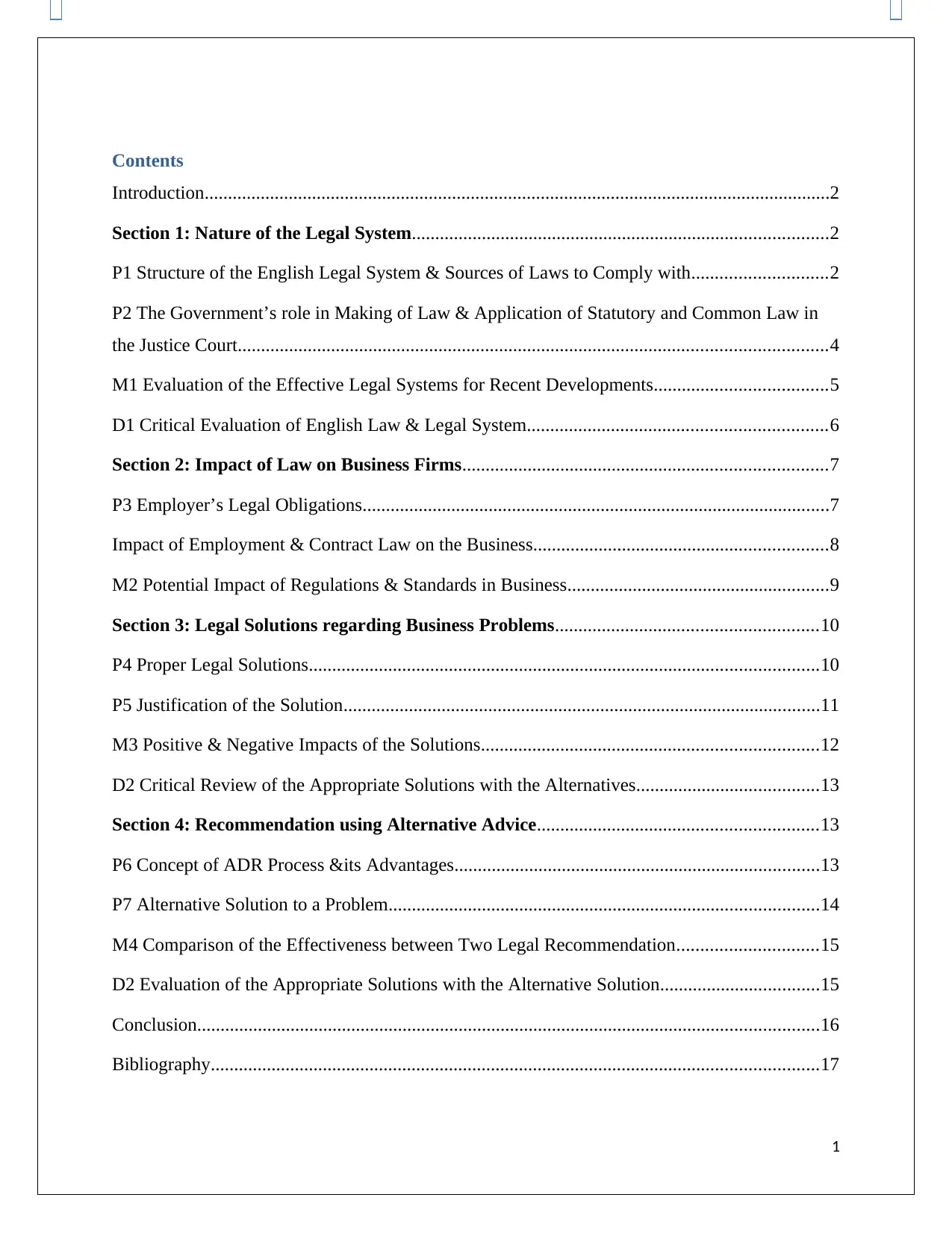
Contents
Introduction......................................................................................................................................2
Section 1: Nature of the Legal System.........................................................................................2
P1 Structure of the English Legal System & Sources of Laws to Comply with.............................2
P2 The Government’s role in Making of Law & Application of Statutory and Common Law in
the Justice Court..............................................................................................................................4
M1 Evaluation of the Effective Legal Systems for Recent Developments.....................................5
D1 Critical Evaluation of English Law & Legal System................................................................6
Section 2: Impact of Law on Business Firms..............................................................................7
P3 Employer’s Legal Obligations....................................................................................................7
Impact of Employment & Contract Law on the Business...............................................................8
M2 Potential Impact of Regulations & Standards in Business........................................................9
Section 3: Legal Solutions regarding Business Problems........................................................10
P4 Proper Legal Solutions.............................................................................................................10
P5 Justification of the Solution......................................................................................................11
M3 Positive & Negative Impacts of the Solutions........................................................................12
D2 Critical Review of the Appropriate Solutions with the Alternatives.......................................13
Section 4: Recommendation using Alternative Advice............................................................13
P6 Concept of ADR Process &its Advantages..............................................................................13
P7 Alternative Solution to a Problem............................................................................................14
M4 Comparison of the Effectiveness between Two Legal Recommendation..............................15
D2 Evaluation of the Appropriate Solutions with the Alternative Solution..................................15
Conclusion.....................................................................................................................................16
Bibliography..................................................................................................................................17
1
Introduction......................................................................................................................................2
Section 1: Nature of the Legal System.........................................................................................2
P1 Structure of the English Legal System & Sources of Laws to Comply with.............................2
P2 The Government’s role in Making of Law & Application of Statutory and Common Law in
the Justice Court..............................................................................................................................4
M1 Evaluation of the Effective Legal Systems for Recent Developments.....................................5
D1 Critical Evaluation of English Law & Legal System................................................................6
Section 2: Impact of Law on Business Firms..............................................................................7
P3 Employer’s Legal Obligations....................................................................................................7
Impact of Employment & Contract Law on the Business...............................................................8
M2 Potential Impact of Regulations & Standards in Business........................................................9
Section 3: Legal Solutions regarding Business Problems........................................................10
P4 Proper Legal Solutions.............................................................................................................10
P5 Justification of the Solution......................................................................................................11
M3 Positive & Negative Impacts of the Solutions........................................................................12
D2 Critical Review of the Appropriate Solutions with the Alternatives.......................................13
Section 4: Recommendation using Alternative Advice............................................................13
P6 Concept of ADR Process &its Advantages..............................................................................13
P7 Alternative Solution to a Problem............................................................................................14
M4 Comparison of the Effectiveness between Two Legal Recommendation..............................15
D2 Evaluation of the Appropriate Solutions with the Alternative Solution..................................15
Conclusion.....................................................................................................................................16
Bibliography..................................................................................................................................17
1
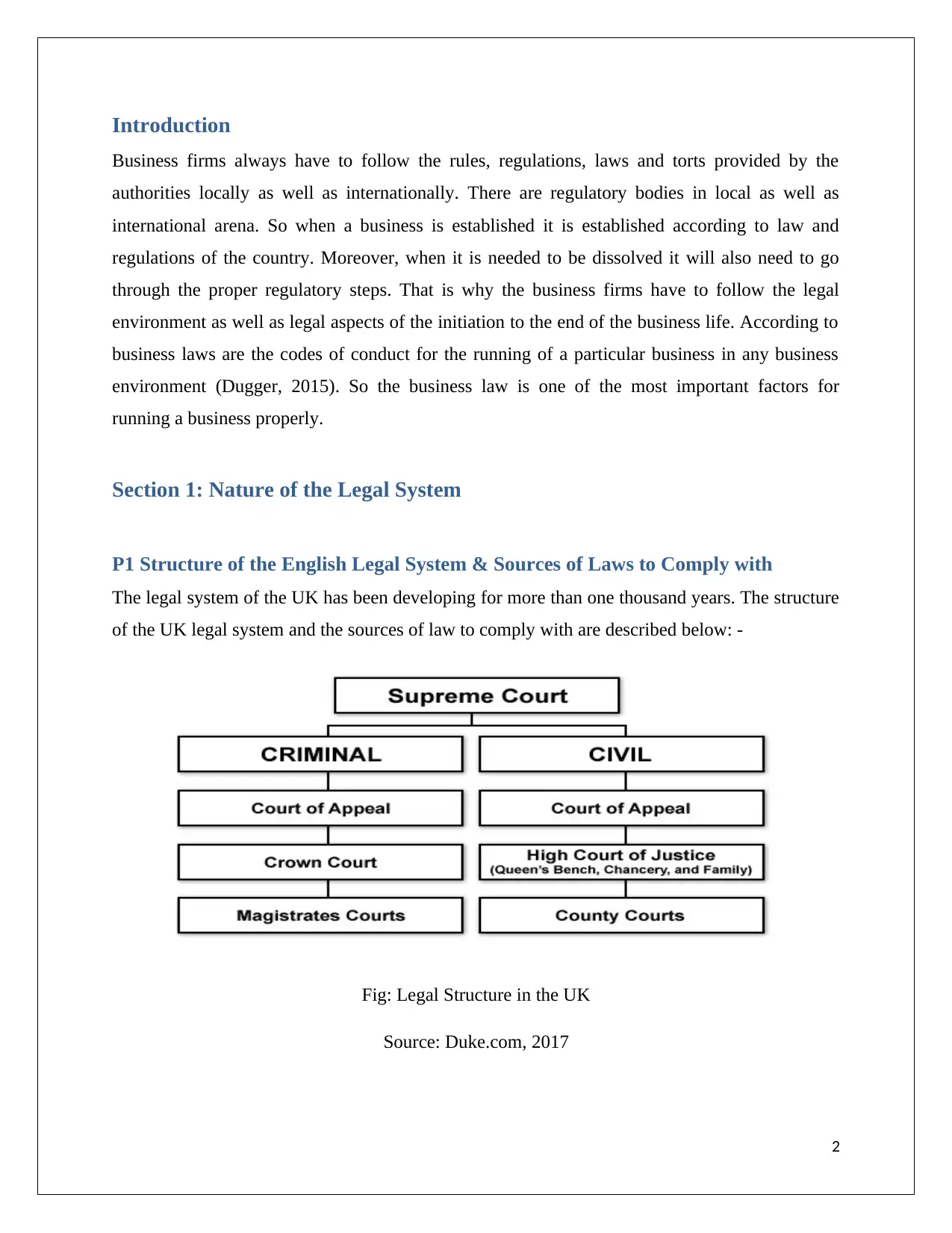
Introduction
Business firms always have to follow the rules, regulations, laws and torts provided by the
authorities locally as well as internationally. There are regulatory bodies in local as well as
international arena. So when a business is established it is established according to law and
regulations of the country. Moreover, when it is needed to be dissolved it will also need to go
through the proper regulatory steps. That is why the business firms have to follow the legal
environment as well as legal aspects of the initiation to the end of the business life. According to
business laws are the codes of conduct for the running of a particular business in any business
environment (Dugger, 2015). So the business law is one of the most important factors for
running a business properly.
Section 1: Nature of the Legal System
P1 Structure of the English Legal System & Sources of Laws to Comply with
The legal system of the UK has been developing for more than one thousand years. The structure
of the UK legal system and the sources of law to comply with are described below: -
Fig: Legal Structure in the UK
Source: Duke.com, 2017
2
Business firms always have to follow the rules, regulations, laws and torts provided by the
authorities locally as well as internationally. There are regulatory bodies in local as well as
international arena. So when a business is established it is established according to law and
regulations of the country. Moreover, when it is needed to be dissolved it will also need to go
through the proper regulatory steps. That is why the business firms have to follow the legal
environment as well as legal aspects of the initiation to the end of the business life. According to
business laws are the codes of conduct for the running of a particular business in any business
environment (Dugger, 2015). So the business law is one of the most important factors for
running a business properly.
Section 1: Nature of the Legal System
P1 Structure of the English Legal System & Sources of Laws to Comply with
The legal system of the UK has been developing for more than one thousand years. The structure
of the UK legal system and the sources of law to comply with are described below: -
Fig: Legal Structure in the UK
Source: Duke.com, 2017
2
⊘ This is a preview!⊘
Do you want full access?
Subscribe today to unlock all pages.

Trusted by 1+ million students worldwide
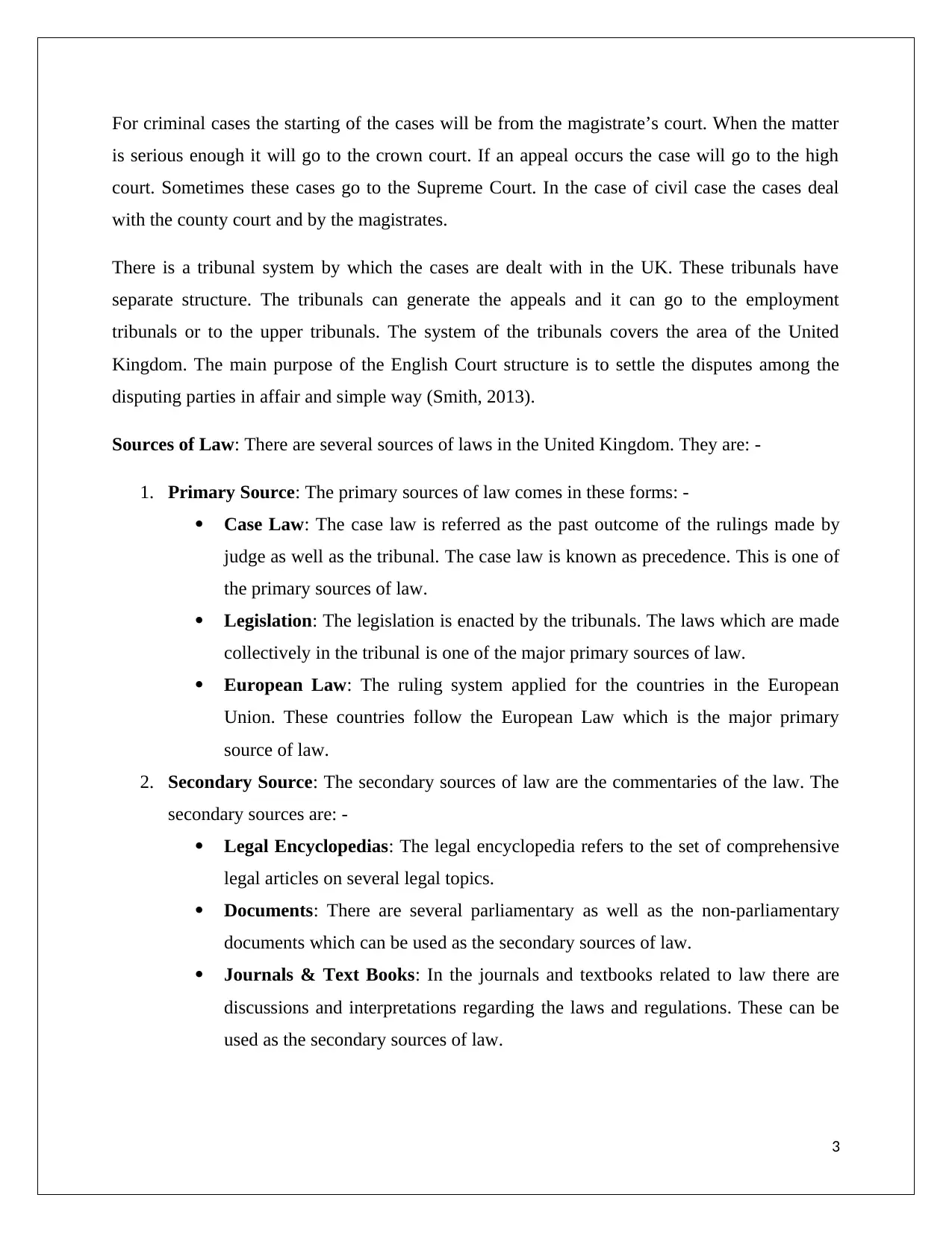
For criminal cases the starting of the cases will be from the magistrate’s court. When the matter
is serious enough it will go to the crown court. If an appeal occurs the case will go to the high
court. Sometimes these cases go to the Supreme Court. In the case of civil case the cases deal
with the county court and by the magistrates.
There is a tribunal system by which the cases are dealt with in the UK. These tribunals have
separate structure. The tribunals can generate the appeals and it can go to the employment
tribunals or to the upper tribunals. The system of the tribunals covers the area of the United
Kingdom. The main purpose of the English Court structure is to settle the disputes among the
disputing parties in affair and simple way (Smith, 2013).
Sources of Law: There are several sources of laws in the United Kingdom. They are: -
1. Primary Source: The primary sources of law comes in these forms: -
Case Law: The case law is referred as the past outcome of the rulings made by
judge as well as the tribunal. The case law is known as precedence. This is one of
the primary sources of law.
Legislation: The legislation is enacted by the tribunals. The laws which are made
collectively in the tribunal is one of the major primary sources of law.
European Law: The ruling system applied for the countries in the European
Union. These countries follow the European Law which is the major primary
source of law.
2. Secondary Source: The secondary sources of law are the commentaries of the law. The
secondary sources are: -
Legal Encyclopedias: The legal encyclopedia refers to the set of comprehensive
legal articles on several legal topics.
Documents: There are several parliamentary as well as the non-parliamentary
documents which can be used as the secondary sources of law.
Journals & Text Books: In the journals and textbooks related to law there are
discussions and interpretations regarding the laws and regulations. These can be
used as the secondary sources of law.
3
is serious enough it will go to the crown court. If an appeal occurs the case will go to the high
court. Sometimes these cases go to the Supreme Court. In the case of civil case the cases deal
with the county court and by the magistrates.
There is a tribunal system by which the cases are dealt with in the UK. These tribunals have
separate structure. The tribunals can generate the appeals and it can go to the employment
tribunals or to the upper tribunals. The system of the tribunals covers the area of the United
Kingdom. The main purpose of the English Court structure is to settle the disputes among the
disputing parties in affair and simple way (Smith, 2013).
Sources of Law: There are several sources of laws in the United Kingdom. They are: -
1. Primary Source: The primary sources of law comes in these forms: -
Case Law: The case law is referred as the past outcome of the rulings made by
judge as well as the tribunal. The case law is known as precedence. This is one of
the primary sources of law.
Legislation: The legislation is enacted by the tribunals. The laws which are made
collectively in the tribunal is one of the major primary sources of law.
European Law: The ruling system applied for the countries in the European
Union. These countries follow the European Law which is the major primary
source of law.
2. Secondary Source: The secondary sources of law are the commentaries of the law. The
secondary sources are: -
Legal Encyclopedias: The legal encyclopedia refers to the set of comprehensive
legal articles on several legal topics.
Documents: There are several parliamentary as well as the non-parliamentary
documents which can be used as the secondary sources of law.
Journals & Text Books: In the journals and textbooks related to law there are
discussions and interpretations regarding the laws and regulations. These can be
used as the secondary sources of law.
3
Paraphrase This Document
Need a fresh take? Get an instant paraphrase of this document with our AI Paraphraser
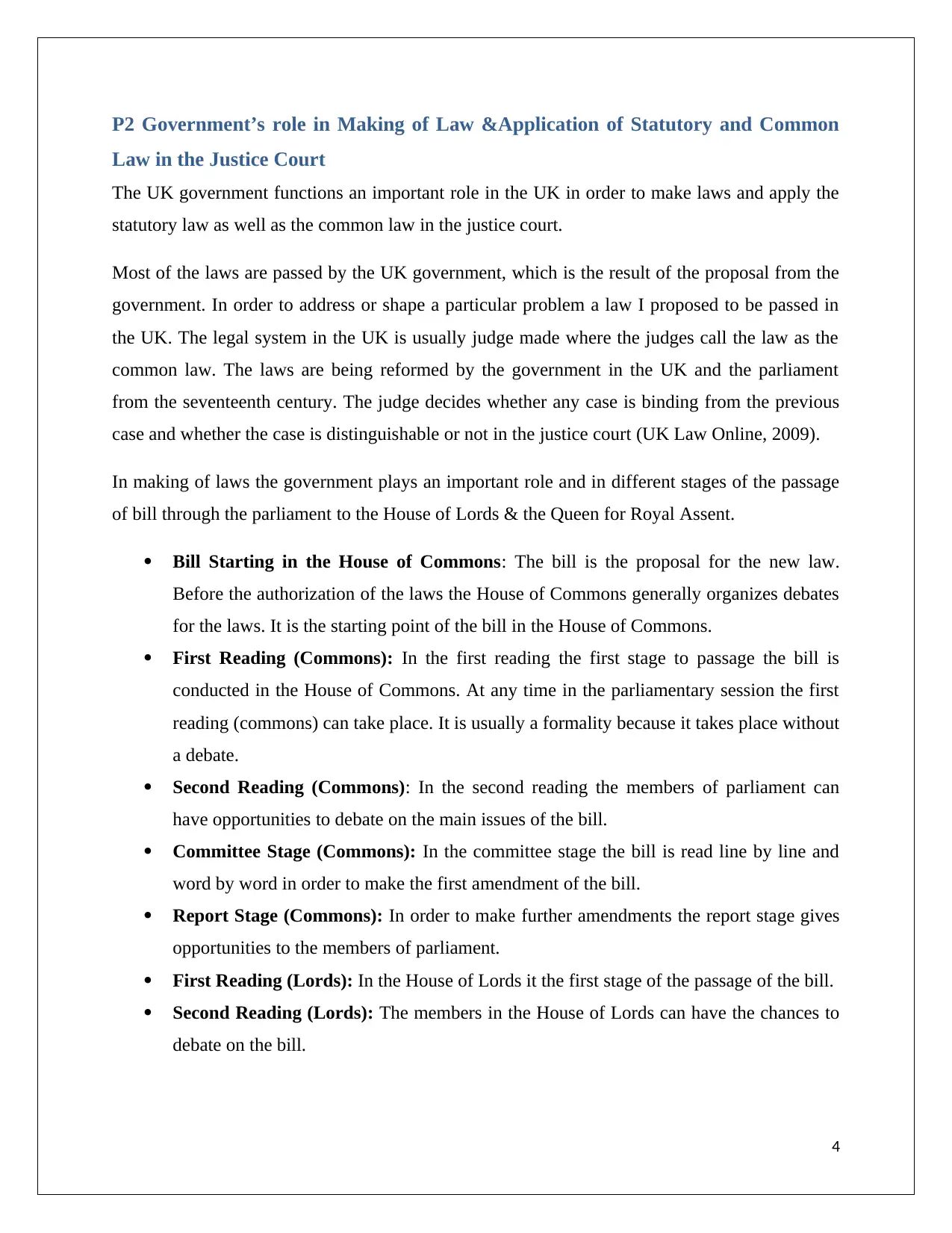
P2 Government’s role in Making of Law &Application of Statutory and Common
Law in the Justice Court
The UK government functions an important role in the UK in order to make laws and apply the
statutory law as well as the common law in the justice court.
Most of the laws are passed by the UK government, which is the result of the proposal from the
government. In order to address or shape a particular problem a law I proposed to be passed in
the UK. The legal system in the UK is usually judge made where the judges call the law as the
common law. The laws are being reformed by the government in the UK and the parliament
from the seventeenth century. The judge decides whether any case is binding from the previous
case and whether the case is distinguishable or not in the justice court (UK Law Online, 2009).
In making of laws the government plays an important role and in different stages of the passage
of bill through the parliament to the House of Lords & the Queen for Royal Assent.
Bill Starting in the House of Commons: The bill is the proposal for the new law.
Before the authorization of the laws the House of Commons generally organizes debates
for the laws. It is the starting point of the bill in the House of Commons.
First Reading (Commons): In the first reading the first stage to passage the bill is
conducted in the House of Commons. At any time in the parliamentary session the first
reading (commons) can take place. It is usually a formality because it takes place without
a debate.
Second Reading (Commons): In the second reading the members of parliament can
have opportunities to debate on the main issues of the bill.
Committee Stage (Commons): In the committee stage the bill is read line by line and
word by word in order to make the first amendment of the bill.
Report Stage (Commons): In order to make further amendments the report stage gives
opportunities to the members of parliament.
First Reading (Lords): In the House of Lords it the first stage of the passage of the bill.
Second Reading (Lords): The members in the House of Lords can have the chances to
debate on the bill.
4
Law in the Justice Court
The UK government functions an important role in the UK in order to make laws and apply the
statutory law as well as the common law in the justice court.
Most of the laws are passed by the UK government, which is the result of the proposal from the
government. In order to address or shape a particular problem a law I proposed to be passed in
the UK. The legal system in the UK is usually judge made where the judges call the law as the
common law. The laws are being reformed by the government in the UK and the parliament
from the seventeenth century. The judge decides whether any case is binding from the previous
case and whether the case is distinguishable or not in the justice court (UK Law Online, 2009).
In making of laws the government plays an important role and in different stages of the passage
of bill through the parliament to the House of Lords & the Queen for Royal Assent.
Bill Starting in the House of Commons: The bill is the proposal for the new law.
Before the authorization of the laws the House of Commons generally organizes debates
for the laws. It is the starting point of the bill in the House of Commons.
First Reading (Commons): In the first reading the first stage to passage the bill is
conducted in the House of Commons. At any time in the parliamentary session the first
reading (commons) can take place. It is usually a formality because it takes place without
a debate.
Second Reading (Commons): In the second reading the members of parliament can
have opportunities to debate on the main issues of the bill.
Committee Stage (Commons): In the committee stage the bill is read line by line and
word by word in order to make the first amendment of the bill.
Report Stage (Commons): In order to make further amendments the report stage gives
opportunities to the members of parliament.
First Reading (Lords): In the House of Lords it the first stage of the passage of the bill.
Second Reading (Lords): The members in the House of Lords can have the chances to
debate on the bill.
4
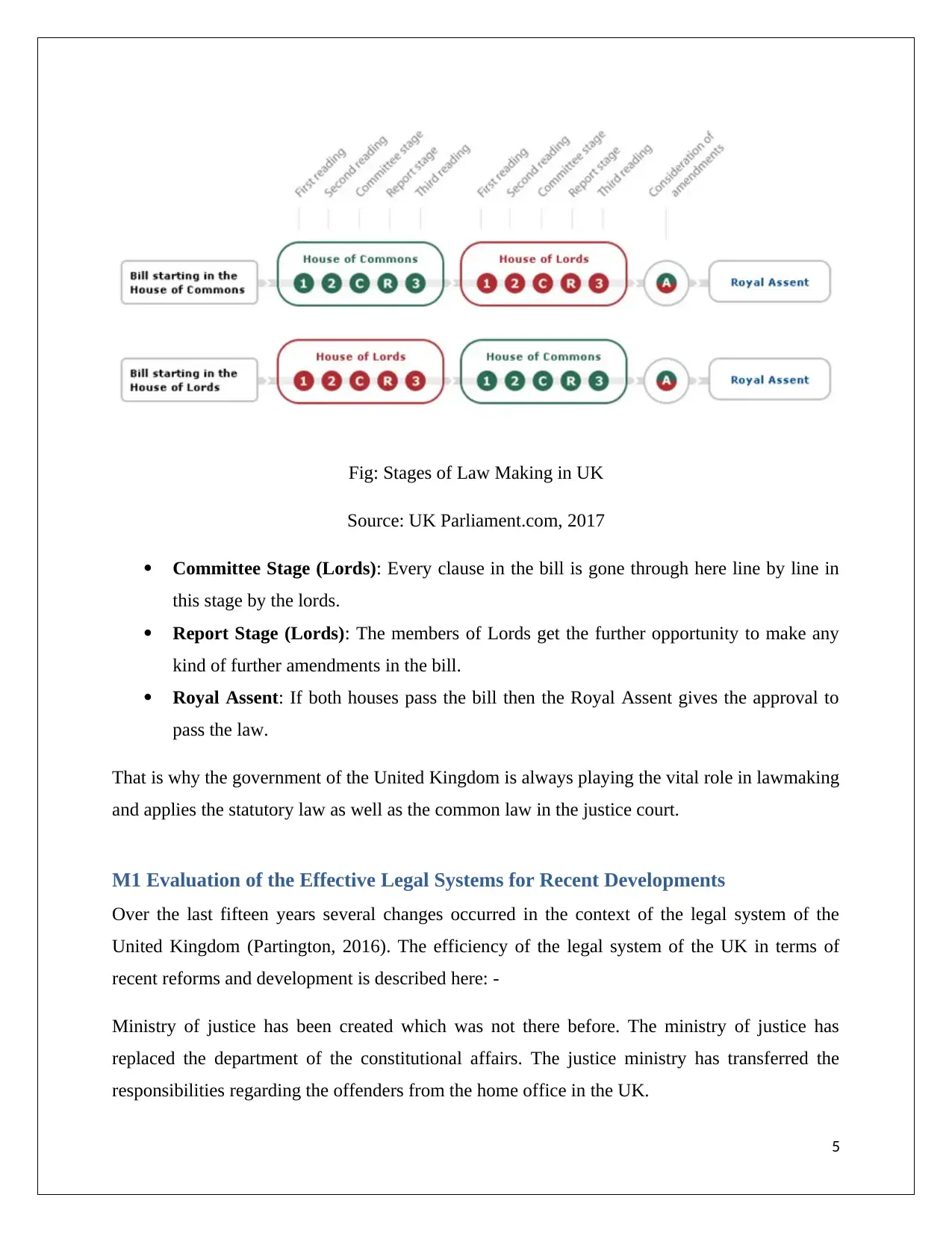
Fig: Stages of Law Making in UK
Source: UK Parliament.com, 2017
Committee Stage (Lords): Every clause in the bill is gone through here line by line in
this stage by the lords.
Report Stage (Lords): The members of Lords get the further opportunity to make any
kind of further amendments in the bill.
Royal Assent: If both houses pass the bill then the Royal Assent gives the approval to
pass the law.
That is why the government of the United Kingdom is always playing the vital role in lawmaking
and applies the statutory law as well as the common law in the justice court.
M1 Evaluation of the Effective Legal Systems for Recent Developments
Over the last fifteen years several changes occurred in the context of the legal system of the
United Kingdom (Partington, 2016). The efficiency of the legal system of the UK in terms of
recent reforms and development is described here: -
Ministry of justice has been created which was not there before. The ministry of justice has
replaced the department of the constitutional affairs. The justice ministry has transferred the
responsibilities regarding the offenders from the home office in the UK.
5
Source: UK Parliament.com, 2017
Committee Stage (Lords): Every clause in the bill is gone through here line by line in
this stage by the lords.
Report Stage (Lords): The members of Lords get the further opportunity to make any
kind of further amendments in the bill.
Royal Assent: If both houses pass the bill then the Royal Assent gives the approval to
pass the law.
That is why the government of the United Kingdom is always playing the vital role in lawmaking
and applies the statutory law as well as the common law in the justice court.
M1 Evaluation of the Effective Legal Systems for Recent Developments
Over the last fifteen years several changes occurred in the context of the legal system of the
United Kingdom (Partington, 2016). The efficiency of the legal system of the UK in terms of
recent reforms and development is described here: -
Ministry of justice has been created which was not there before. The ministry of justice has
replaced the department of the constitutional affairs. The justice ministry has transferred the
responsibilities regarding the offenders from the home office in the UK.
5
⊘ This is a preview!⊘
Do you want full access?
Subscribe today to unlock all pages.

Trusted by 1+ million students worldwide
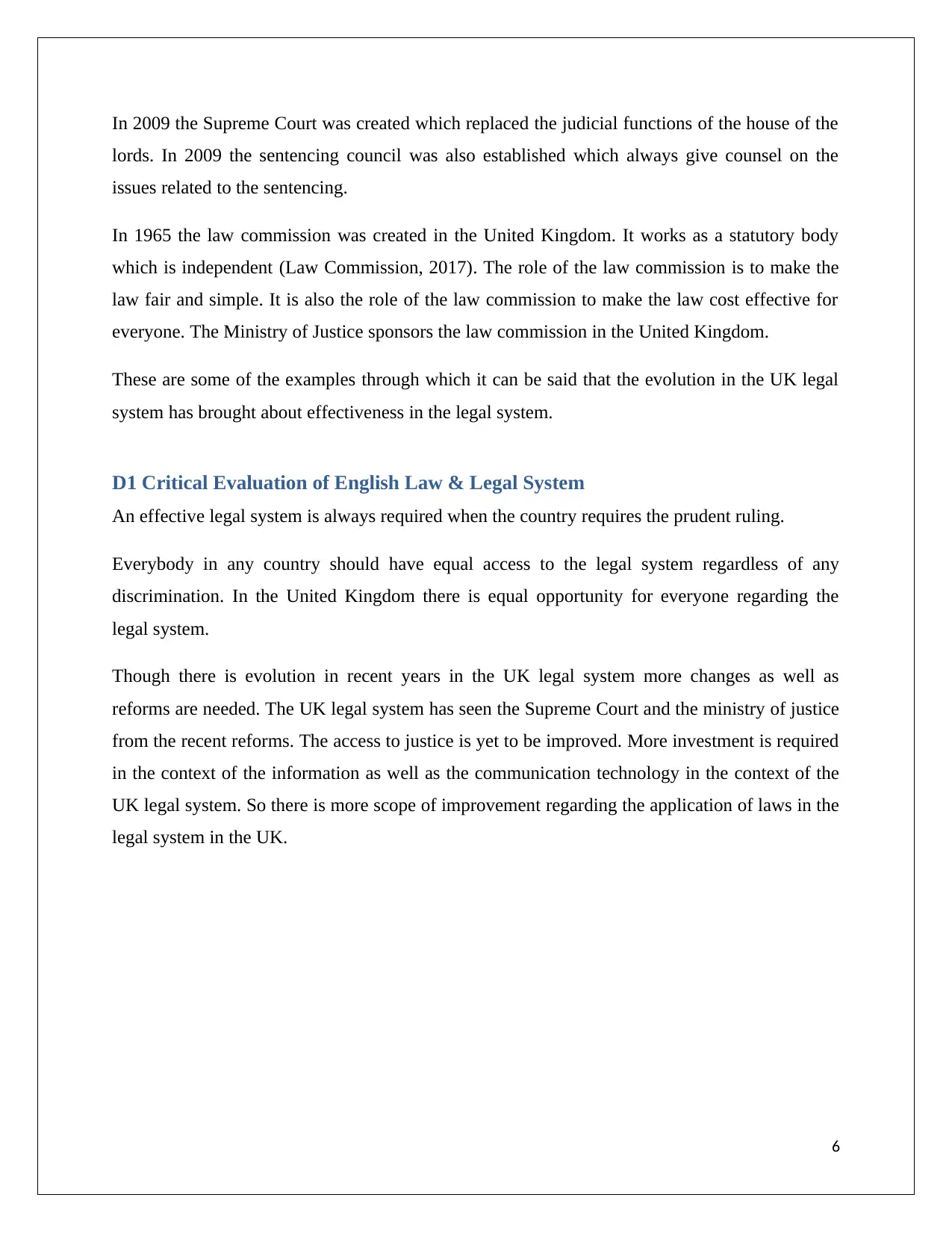
In 2009 the Supreme Court was created which replaced the judicial functions of the house of the
lords. In 2009 the sentencing council was also established which always give counsel on the
issues related to the sentencing.
In 1965 the law commission was created in the United Kingdom. It works as a statutory body
which is independent (Law Commission, 2017). The role of the law commission is to make the
law fair and simple. It is also the role of the law commission to make the law cost effective for
everyone. The Ministry of Justice sponsors the law commission in the United Kingdom.
These are some of the examples through which it can be said that the evolution in the UK legal
system has brought about effectiveness in the legal system.
D1 Critical Evaluation of English Law & Legal System
An effective legal system is always required when the country requires the prudent ruling.
Everybody in any country should have equal access to the legal system regardless of any
discrimination. In the United Kingdom there is equal opportunity for everyone regarding the
legal system.
Though there is evolution in recent years in the UK legal system more changes as well as
reforms are needed. The UK legal system has seen the Supreme Court and the ministry of justice
from the recent reforms. The access to justice is yet to be improved. More investment is required
in the context of the information as well as the communication technology in the context of the
UK legal system. So there is more scope of improvement regarding the application of laws in the
legal system in the UK.
6
lords. In 2009 the sentencing council was also established which always give counsel on the
issues related to the sentencing.
In 1965 the law commission was created in the United Kingdom. It works as a statutory body
which is independent (Law Commission, 2017). The role of the law commission is to make the
law fair and simple. It is also the role of the law commission to make the law cost effective for
everyone. The Ministry of Justice sponsors the law commission in the United Kingdom.
These are some of the examples through which it can be said that the evolution in the UK legal
system has brought about effectiveness in the legal system.
D1 Critical Evaluation of English Law & Legal System
An effective legal system is always required when the country requires the prudent ruling.
Everybody in any country should have equal access to the legal system regardless of any
discrimination. In the United Kingdom there is equal opportunity for everyone regarding the
legal system.
Though there is evolution in recent years in the UK legal system more changes as well as
reforms are needed. The UK legal system has seen the Supreme Court and the ministry of justice
from the recent reforms. The access to justice is yet to be improved. More investment is required
in the context of the information as well as the communication technology in the context of the
UK legal system. So there is more scope of improvement regarding the application of laws in the
legal system in the UK.
6
Paraphrase This Document
Need a fresh take? Get an instant paraphrase of this document with our AI Paraphraser
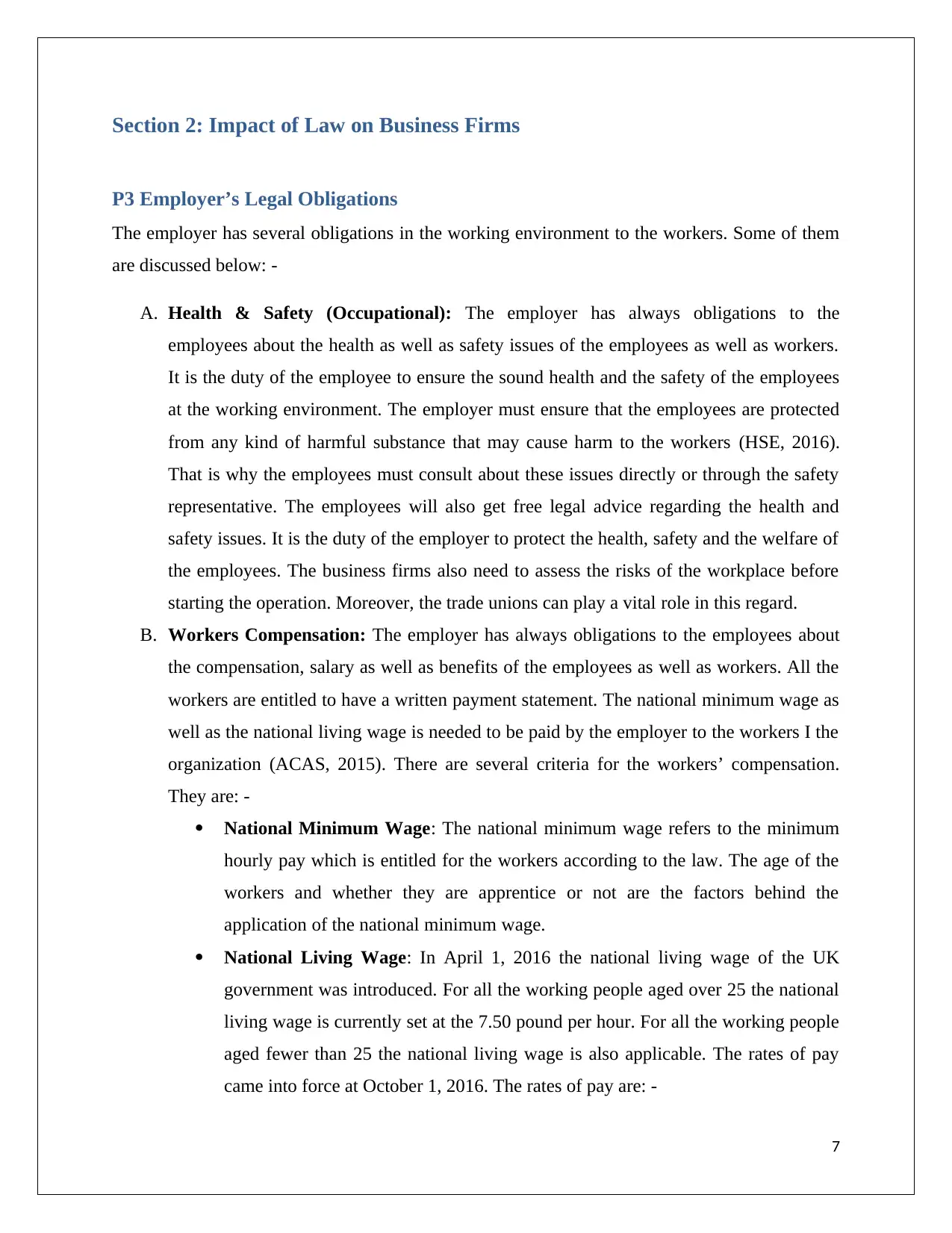
Section 2: Impact of Law on Business Firms
P3 Employer’s Legal Obligations
The employer has several obligations in the working environment to the workers. Some of them
are discussed below: -
A. Health & Safety (Occupational): The employer has always obligations to the
employees about the health as well as safety issues of the employees as well as workers.
It is the duty of the employee to ensure the sound health and the safety of the employees
at the working environment. The employer must ensure that the employees are protected
from any kind of harmful substance that may cause harm to the workers (HSE, 2016).
That is why the employees must consult about these issues directly or through the safety
representative. The employees will also get free legal advice regarding the health and
safety issues. It is the duty of the employer to protect the health, safety and the welfare of
the employees. The business firms also need to assess the risks of the workplace before
starting the operation. Moreover, the trade unions can play a vital role in this regard.
B. Workers Compensation: The employer has always obligations to the employees about
the compensation, salary as well as benefits of the employees as well as workers. All the
workers are entitled to have a written payment statement. The national minimum wage as
well as the national living wage is needed to be paid by the employer to the workers I the
organization (ACAS, 2015). There are several criteria for the workers’ compensation.
They are: -
National Minimum Wage: The national minimum wage refers to the minimum
hourly pay which is entitled for the workers according to the law. The age of the
workers and whether they are apprentice or not are the factors behind the
application of the national minimum wage.
National Living Wage: In April 1, 2016 the national living wage of the UK
government was introduced. For all the working people aged over 25 the national
living wage is currently set at the 7.50 pound per hour. For all the working people
aged fewer than 25 the national living wage is also applicable. The rates of pay
came into force at October 1, 2016. The rates of pay are: -
7
P3 Employer’s Legal Obligations
The employer has several obligations in the working environment to the workers. Some of them
are discussed below: -
A. Health & Safety (Occupational): The employer has always obligations to the
employees about the health as well as safety issues of the employees as well as workers.
It is the duty of the employee to ensure the sound health and the safety of the employees
at the working environment. The employer must ensure that the employees are protected
from any kind of harmful substance that may cause harm to the workers (HSE, 2016).
That is why the employees must consult about these issues directly or through the safety
representative. The employees will also get free legal advice regarding the health and
safety issues. It is the duty of the employer to protect the health, safety and the welfare of
the employees. The business firms also need to assess the risks of the workplace before
starting the operation. Moreover, the trade unions can play a vital role in this regard.
B. Workers Compensation: The employer has always obligations to the employees about
the compensation, salary as well as benefits of the employees as well as workers. All the
workers are entitled to have a written payment statement. The national minimum wage as
well as the national living wage is needed to be paid by the employer to the workers I the
organization (ACAS, 2015). There are several criteria for the workers’ compensation.
They are: -
National Minimum Wage: The national minimum wage refers to the minimum
hourly pay which is entitled for the workers according to the law. The age of the
workers and whether they are apprentice or not are the factors behind the
application of the national minimum wage.
National Living Wage: In April 1, 2016 the national living wage of the UK
government was introduced. For all the working people aged over 25 the national
living wage is currently set at the 7.50 pound per hour. For all the working people
aged fewer than 25 the national living wage is also applicable. The rates of pay
came into force at October 1, 2016. The rates of pay are: -
7
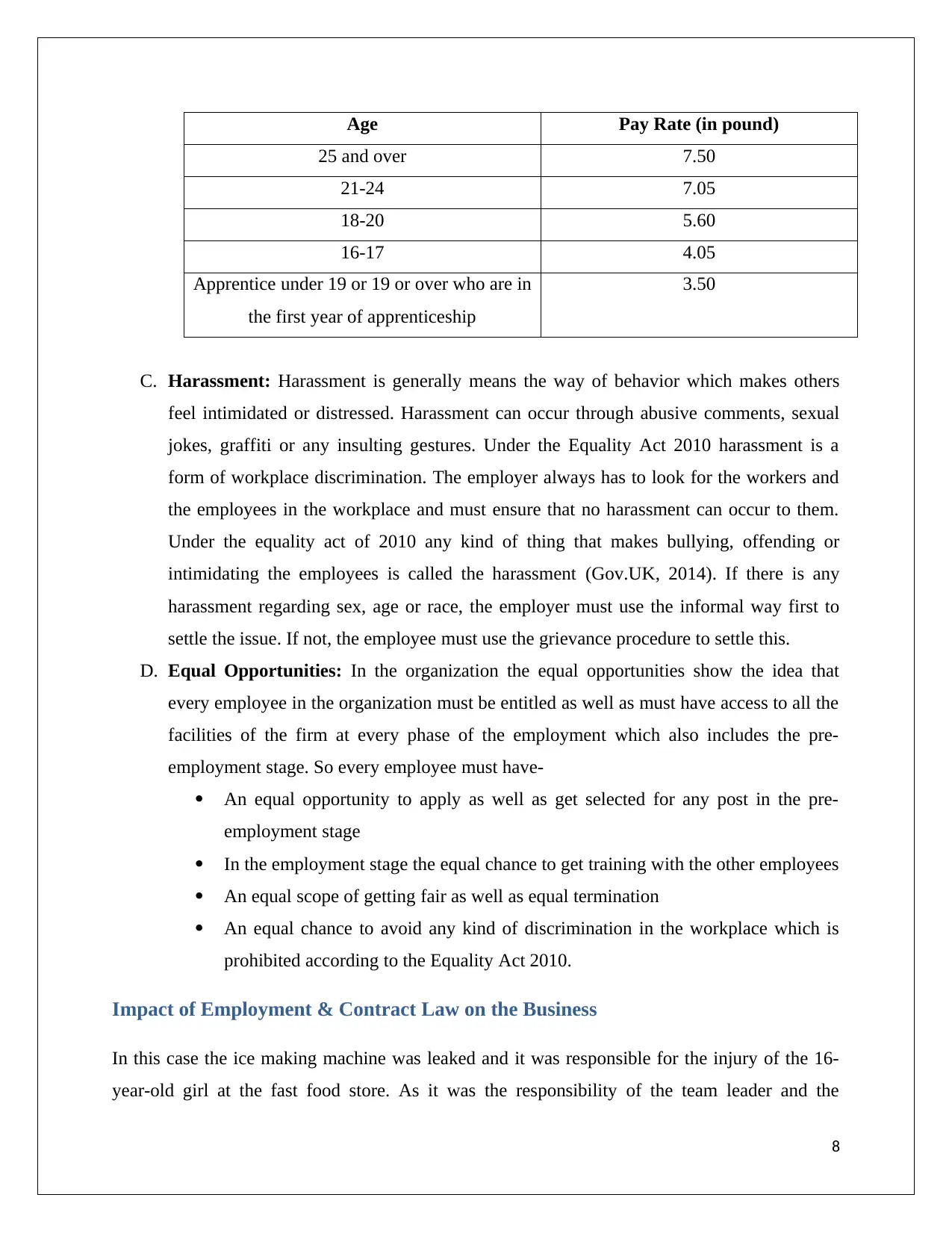
Age Pay Rate (in pound)
25 and over 7.50
21-24 7.05
18-20 5.60
16-17 4.05
Apprentice under 19 or 19 or over who are in
the first year of apprenticeship
3.50
C. Harassment: Harassment is generally means the way of behavior which makes others
feel intimidated or distressed. Harassment can occur through abusive comments, sexual
jokes, graffiti or any insulting gestures. Under the Equality Act 2010 harassment is a
form of workplace discrimination. The employer always has to look for the workers and
the employees in the workplace and must ensure that no harassment can occur to them.
Under the equality act of 2010 any kind of thing that makes bullying, offending or
intimidating the employees is called the harassment (Gov.UK, 2014). If there is any
harassment regarding sex, age or race, the employer must use the informal way first to
settle the issue. If not, the employee must use the grievance procedure to settle this.
D. Equal Opportunities: In the organization the equal opportunities show the idea that
every employee in the organization must be entitled as well as must have access to all the
facilities of the firm at every phase of the employment which also includes the pre-
employment stage. So every employee must have-
An equal opportunity to apply as well as get selected for any post in the pre-
employment stage
In the employment stage the equal chance to get training with the other employees
An equal scope of getting fair as well as equal termination
An equal chance to avoid any kind of discrimination in the workplace which is
prohibited according to the Equality Act 2010.
Impact of Employment & Contract Law on the Business
In this case the ice making machine was leaked and it was responsible for the injury of the 16-
year-old girl at the fast food store. As it was the responsibility of the team leader and the
8
25 and over 7.50
21-24 7.05
18-20 5.60
16-17 4.05
Apprentice under 19 or 19 or over who are in
the first year of apprenticeship
3.50
C. Harassment: Harassment is generally means the way of behavior which makes others
feel intimidated or distressed. Harassment can occur through abusive comments, sexual
jokes, graffiti or any insulting gestures. Under the Equality Act 2010 harassment is a
form of workplace discrimination. The employer always has to look for the workers and
the employees in the workplace and must ensure that no harassment can occur to them.
Under the equality act of 2010 any kind of thing that makes bullying, offending or
intimidating the employees is called the harassment (Gov.UK, 2014). If there is any
harassment regarding sex, age or race, the employer must use the informal way first to
settle the issue. If not, the employee must use the grievance procedure to settle this.
D. Equal Opportunities: In the organization the equal opportunities show the idea that
every employee in the organization must be entitled as well as must have access to all the
facilities of the firm at every phase of the employment which also includes the pre-
employment stage. So every employee must have-
An equal opportunity to apply as well as get selected for any post in the pre-
employment stage
In the employment stage the equal chance to get training with the other employees
An equal scope of getting fair as well as equal termination
An equal chance to avoid any kind of discrimination in the workplace which is
prohibited according to the Equality Act 2010.
Impact of Employment & Contract Law on the Business
In this case the ice making machine was leaked and it was responsible for the injury of the 16-
year-old girl at the fast food store. As it was the responsibility of the team leader and the
8
⊘ This is a preview!⊘
Do you want full access?
Subscribe today to unlock all pages.

Trusted by 1+ million students worldwide
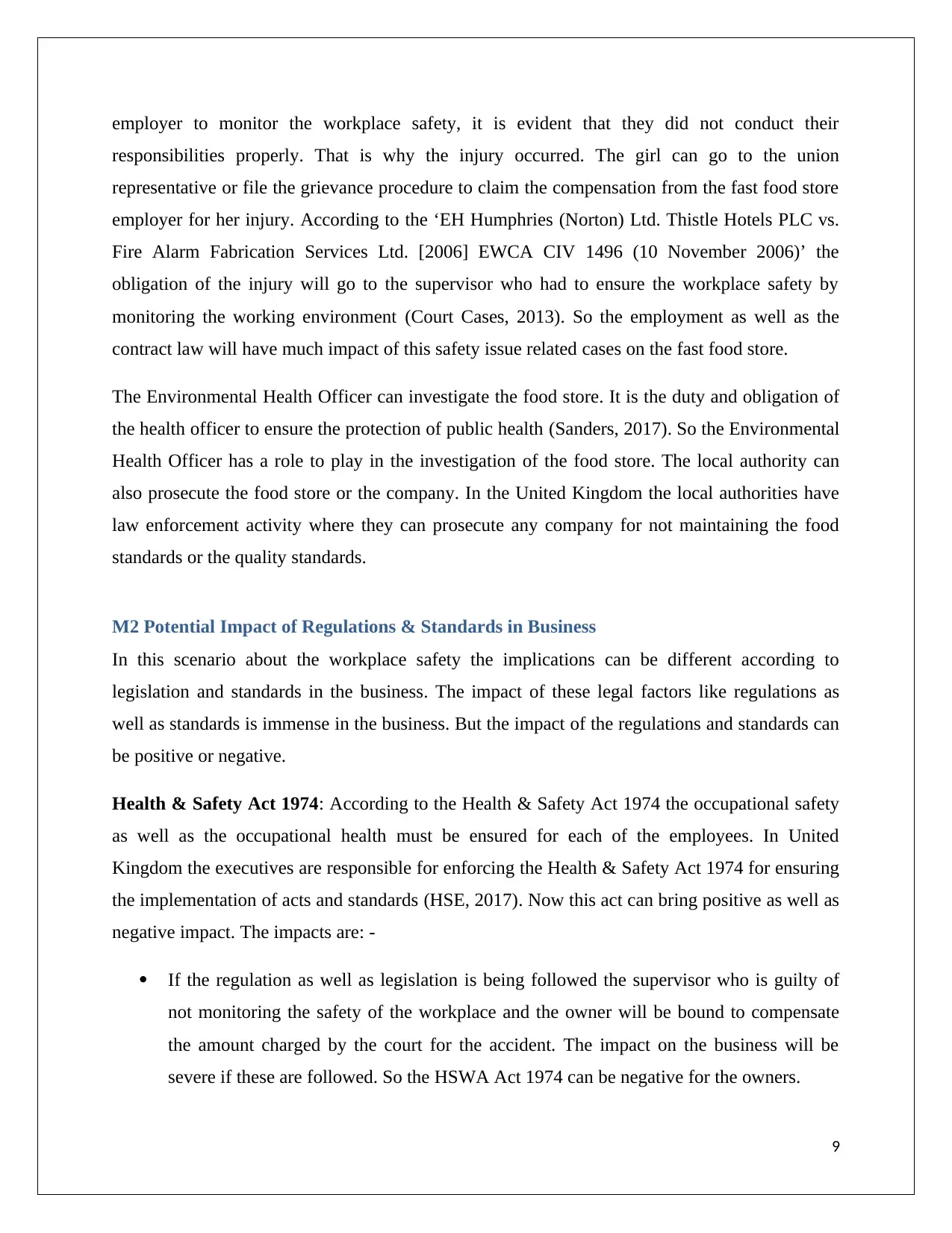
employer to monitor the workplace safety, it is evident that they did not conduct their
responsibilities properly. That is why the injury occurred. The girl can go to the union
representative or file the grievance procedure to claim the compensation from the fast food store
employer for her injury. According to the ‘EH Humphries (Norton) Ltd. Thistle Hotels PLC vs.
Fire Alarm Fabrication Services Ltd. [2006] EWCA CIV 1496 (10 November 2006)’ the
obligation of the injury will go to the supervisor who had to ensure the workplace safety by
monitoring the working environment (Court Cases, 2013). So the employment as well as the
contract law will have much impact of this safety issue related cases on the fast food store.
The Environmental Health Officer can investigate the food store. It is the duty and obligation of
the health officer to ensure the protection of public health (Sanders, 2017). So the Environmental
Health Officer has a role to play in the investigation of the food store. The local authority can
also prosecute the food store or the company. In the United Kingdom the local authorities have
law enforcement activity where they can prosecute any company for not maintaining the food
standards or the quality standards.
M2 Potential Impact of Regulations & Standards in Business
In this scenario about the workplace safety the implications can be different according to
legislation and standards in the business. The impact of these legal factors like regulations as
well as standards is immense in the business. But the impact of the regulations and standards can
be positive or negative.
Health & Safety Act 1974: According to the Health & Safety Act 1974 the occupational safety
as well as the occupational health must be ensured for each of the employees. In United
Kingdom the executives are responsible for enforcing the Health & Safety Act 1974 for ensuring
the implementation of acts and standards (HSE, 2017). Now this act can bring positive as well as
negative impact. The impacts are: -
If the regulation as well as legislation is being followed the supervisor who is guilty of
not monitoring the safety of the workplace and the owner will be bound to compensate
the amount charged by the court for the accident. The impact on the business will be
severe if these are followed. So the HSWA Act 1974 can be negative for the owners.
9
responsibilities properly. That is why the injury occurred. The girl can go to the union
representative or file the grievance procedure to claim the compensation from the fast food store
employer for her injury. According to the ‘EH Humphries (Norton) Ltd. Thistle Hotels PLC vs.
Fire Alarm Fabrication Services Ltd. [2006] EWCA CIV 1496 (10 November 2006)’ the
obligation of the injury will go to the supervisor who had to ensure the workplace safety by
monitoring the working environment (Court Cases, 2013). So the employment as well as the
contract law will have much impact of this safety issue related cases on the fast food store.
The Environmental Health Officer can investigate the food store. It is the duty and obligation of
the health officer to ensure the protection of public health (Sanders, 2017). So the Environmental
Health Officer has a role to play in the investigation of the food store. The local authority can
also prosecute the food store or the company. In the United Kingdom the local authorities have
law enforcement activity where they can prosecute any company for not maintaining the food
standards or the quality standards.
M2 Potential Impact of Regulations & Standards in Business
In this scenario about the workplace safety the implications can be different according to
legislation and standards in the business. The impact of these legal factors like regulations as
well as standards is immense in the business. But the impact of the regulations and standards can
be positive or negative.
Health & Safety Act 1974: According to the Health & Safety Act 1974 the occupational safety
as well as the occupational health must be ensured for each of the employees. In United
Kingdom the executives are responsible for enforcing the Health & Safety Act 1974 for ensuring
the implementation of acts and standards (HSE, 2017). Now this act can bring positive as well as
negative impact. The impacts are: -
If the regulation as well as legislation is being followed the supervisor who is guilty of
not monitoring the safety of the workplace and the owner will be bound to compensate
the amount charged by the court for the accident. The impact on the business will be
severe if these are followed. So the HSWA Act 1974 can be negative for the owners.
9
Paraphrase This Document
Need a fresh take? Get an instant paraphrase of this document with our AI Paraphraser
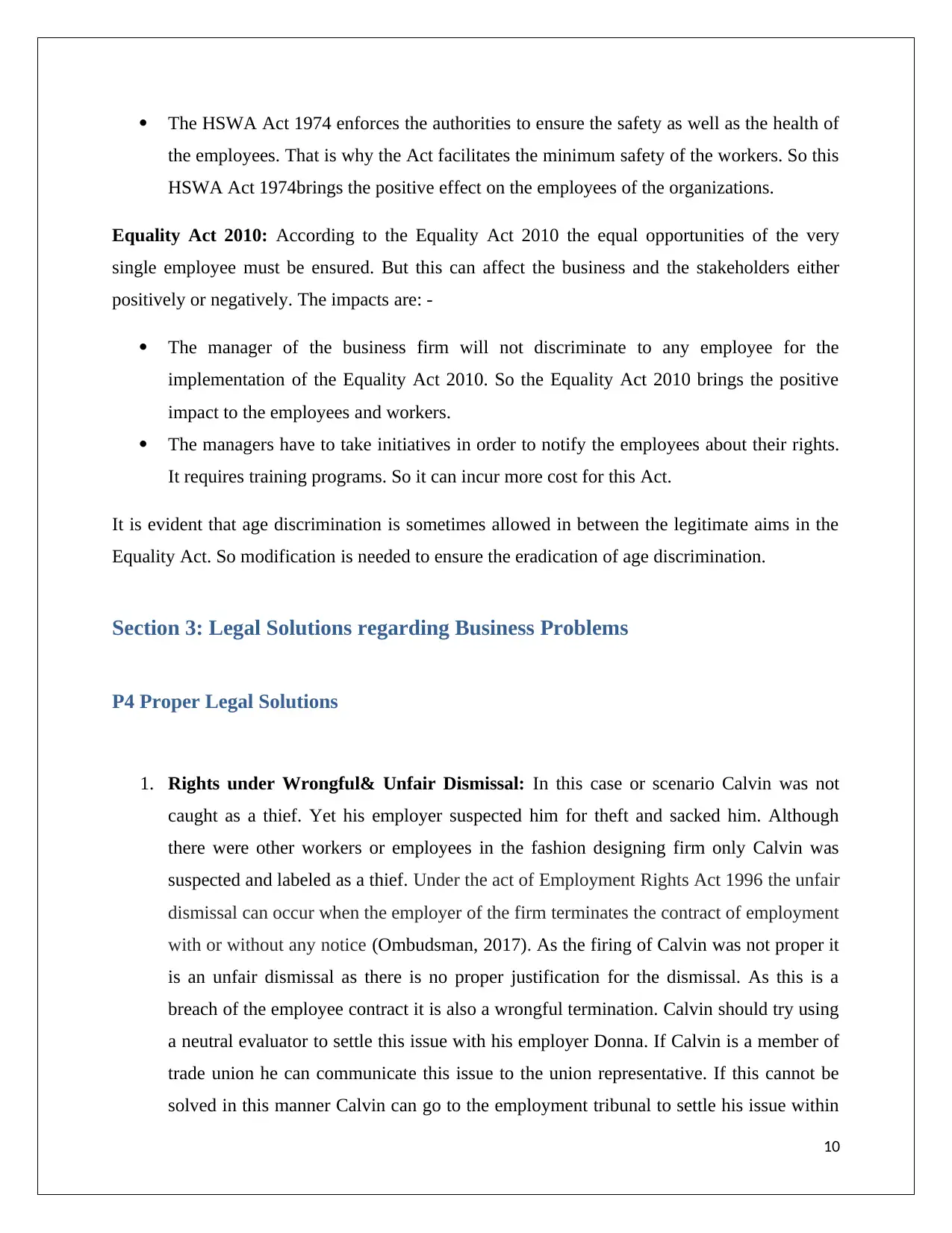
The HSWA Act 1974 enforces the authorities to ensure the safety as well as the health of
the employees. That is why the Act facilitates the minimum safety of the workers. So this
HSWA Act 1974brings the positive effect on the employees of the organizations.
Equality Act 2010: According to the Equality Act 2010 the equal opportunities of the very
single employee must be ensured. But this can affect the business and the stakeholders either
positively or negatively. The impacts are: -
The manager of the business firm will not discriminate to any employee for the
implementation of the Equality Act 2010. So the Equality Act 2010 brings the positive
impact to the employees and workers.
The managers have to take initiatives in order to notify the employees about their rights.
It requires training programs. So it can incur more cost for this Act.
It is evident that age discrimination is sometimes allowed in between the legitimate aims in the
Equality Act. So modification is needed to ensure the eradication of age discrimination.
Section 3: Legal Solutions regarding Business Problems
P4 Proper Legal Solutions
1. Rights under Wrongful& Unfair Dismissal: In this case or scenario Calvin was not
caught as a thief. Yet his employer suspected him for theft and sacked him. Although
there were other workers or employees in the fashion designing firm only Calvin was
suspected and labeled as a thief. Under the act of Employment Rights Act 1996 the unfair
dismissal can occur when the employer of the firm terminates the contract of employment
with or without any notice (Ombudsman, 2017). As the firing of Calvin was not proper it
is an unfair dismissal as there is no proper justification for the dismissal. As this is a
breach of the employee contract it is also a wrongful termination. Calvin should try using
a neutral evaluator to settle this issue with his employer Donna. If Calvin is a member of
trade union he can communicate this issue to the union representative. If this cannot be
solved in this manner Calvin can go to the employment tribunal to settle his issue within
10
the employees. That is why the Act facilitates the minimum safety of the workers. So this
HSWA Act 1974brings the positive effect on the employees of the organizations.
Equality Act 2010: According to the Equality Act 2010 the equal opportunities of the very
single employee must be ensured. But this can affect the business and the stakeholders either
positively or negatively. The impacts are: -
The manager of the business firm will not discriminate to any employee for the
implementation of the Equality Act 2010. So the Equality Act 2010 brings the positive
impact to the employees and workers.
The managers have to take initiatives in order to notify the employees about their rights.
It requires training programs. So it can incur more cost for this Act.
It is evident that age discrimination is sometimes allowed in between the legitimate aims in the
Equality Act. So modification is needed to ensure the eradication of age discrimination.
Section 3: Legal Solutions regarding Business Problems
P4 Proper Legal Solutions
1. Rights under Wrongful& Unfair Dismissal: In this case or scenario Calvin was not
caught as a thief. Yet his employer suspected him for theft and sacked him. Although
there were other workers or employees in the fashion designing firm only Calvin was
suspected and labeled as a thief. Under the act of Employment Rights Act 1996 the unfair
dismissal can occur when the employer of the firm terminates the contract of employment
with or without any notice (Ombudsman, 2017). As the firing of Calvin was not proper it
is an unfair dismissal as there is no proper justification for the dismissal. As this is a
breach of the employee contract it is also a wrongful termination. Calvin should try using
a neutral evaluator to settle this issue with his employer Donna. If Calvin is a member of
trade union he can communicate this issue to the union representative. If this cannot be
solved in this manner Calvin can go to the employment tribunal to settle his issue within
10
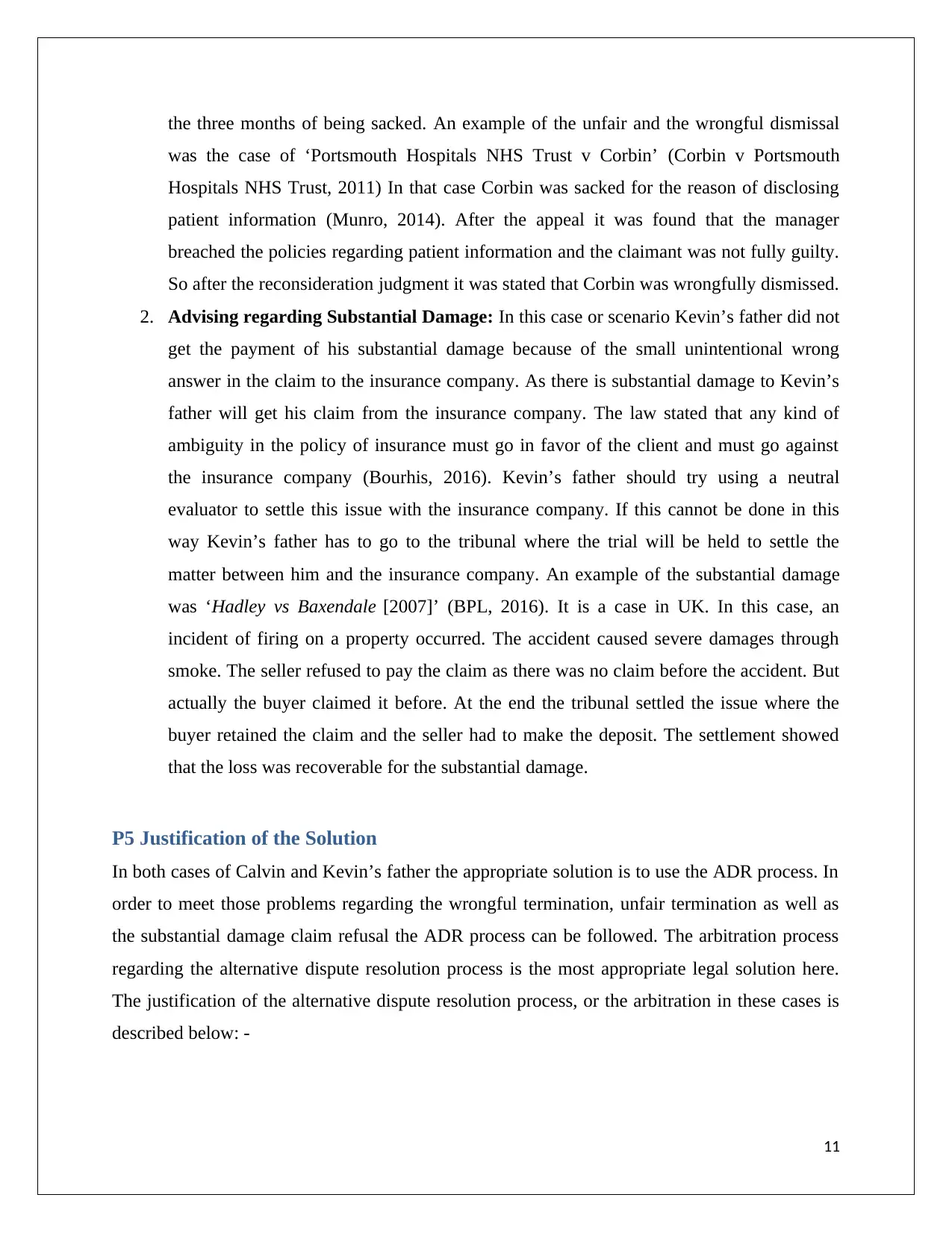
the three months of being sacked. An example of the unfair and the wrongful dismissal
was the case of ‘Portsmouth Hospitals NHS Trust v Corbin’ (Corbin v Portsmouth
Hospitals NHS Trust, 2011) In that case Corbin was sacked for the reason of disclosing
patient information (Munro, 2014). After the appeal it was found that the manager
breached the policies regarding patient information and the claimant was not fully guilty.
So after the reconsideration judgment it was stated that Corbin was wrongfully dismissed.
2. Advising regarding Substantial Damage: In this case or scenario Kevin’s father did not
get the payment of his substantial damage because of the small unintentional wrong
answer in the claim to the insurance company. As there is substantial damage to Kevin’s
father will get his claim from the insurance company. The law stated that any kind of
ambiguity in the policy of insurance must go in favor of the client and must go against
the insurance company (Bourhis, 2016). Kevin’s father should try using a neutral
evaluator to settle this issue with the insurance company. If this cannot be done in this
way Kevin’s father has to go to the tribunal where the trial will be held to settle the
matter between him and the insurance company. An example of the substantial damage
was ‘Hadley vs Baxendale [2007]’ (BPL, 2016). It is a case in UK. In this case, an
incident of firing on a property occurred. The accident caused severe damages through
smoke. The seller refused to pay the claim as there was no claim before the accident. But
actually the buyer claimed it before. At the end the tribunal settled the issue where the
buyer retained the claim and the seller had to make the deposit. The settlement showed
that the loss was recoverable for the substantial damage.
P5 Justification of the Solution
In both cases of Calvin and Kevin’s father the appropriate solution is to use the ADR process. In
order to meet those problems regarding the wrongful termination, unfair termination as well as
the substantial damage claim refusal the ADR process can be followed. The arbitration process
regarding the alternative dispute resolution process is the most appropriate legal solution here.
The justification of the alternative dispute resolution process, or the arbitration in these cases is
described below: -
11
was the case of ‘Portsmouth Hospitals NHS Trust v Corbin’ (Corbin v Portsmouth
Hospitals NHS Trust, 2011) In that case Corbin was sacked for the reason of disclosing
patient information (Munro, 2014). After the appeal it was found that the manager
breached the policies regarding patient information and the claimant was not fully guilty.
So after the reconsideration judgment it was stated that Corbin was wrongfully dismissed.
2. Advising regarding Substantial Damage: In this case or scenario Kevin’s father did not
get the payment of his substantial damage because of the small unintentional wrong
answer in the claim to the insurance company. As there is substantial damage to Kevin’s
father will get his claim from the insurance company. The law stated that any kind of
ambiguity in the policy of insurance must go in favor of the client and must go against
the insurance company (Bourhis, 2016). Kevin’s father should try using a neutral
evaluator to settle this issue with the insurance company. If this cannot be done in this
way Kevin’s father has to go to the tribunal where the trial will be held to settle the
matter between him and the insurance company. An example of the substantial damage
was ‘Hadley vs Baxendale [2007]’ (BPL, 2016). It is a case in UK. In this case, an
incident of firing on a property occurred. The accident caused severe damages through
smoke. The seller refused to pay the claim as there was no claim before the accident. But
actually the buyer claimed it before. At the end the tribunal settled the issue where the
buyer retained the claim and the seller had to make the deposit. The settlement showed
that the loss was recoverable for the substantial damage.
P5 Justification of the Solution
In both cases of Calvin and Kevin’s father the appropriate solution is to use the ADR process. In
order to meet those problems regarding the wrongful termination, unfair termination as well as
the substantial damage claim refusal the ADR process can be followed. The arbitration process
regarding the alternative dispute resolution process is the most appropriate legal solution here.
The justification of the alternative dispute resolution process, or the arbitration in these cases is
described below: -
11
⊘ This is a preview!⊘
Do you want full access?
Subscribe today to unlock all pages.

Trusted by 1+ million students worldwide
1 out of 19
Related Documents
Your All-in-One AI-Powered Toolkit for Academic Success.
+13062052269
info@desklib.com
Available 24*7 on WhatsApp / Email
![[object Object]](/_next/static/media/star-bottom.7253800d.svg)
Unlock your academic potential
Copyright © 2020–2025 A2Z Services. All Rights Reserved. Developed and managed by ZUCOL.





